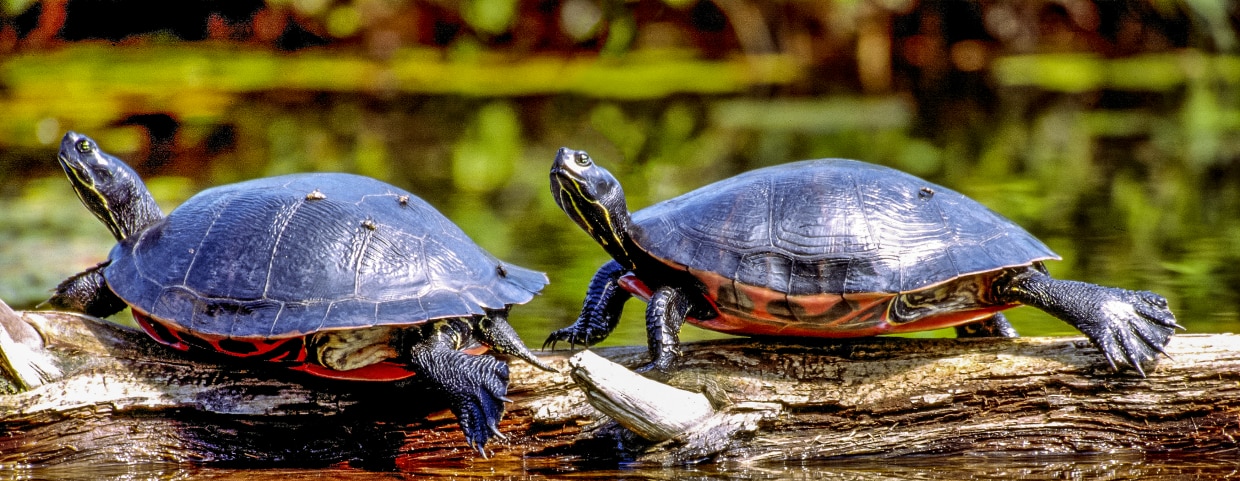Fast facts
Common name: Northern red-bellied cooter
Scientific name: Pseudemys rubriventris
Size: Males: 10–12 inches long; females: 11–13.5 inches long; weigh up to 12.7 pounds
Range: Massachusetts population: Plymouth and eastern Bristol counties; primary range: New Jersey coastal plain south to North Carolina's Outer Banks, inland to West Virginia's Potomac watershed
Conservation status: State listed and federally listed as endangered
Fun fact: Life expectancy is believed to be more than 50 years
Description
Northern red-bellied cooters are large basking turtles. Their size and coloration make them distinct. Adults have black to brown carapaces, or upper shells, with faint reddish markings. Plastrons, or bottom shells, of males are pale pink with dark mottling. Adult females have red plastrons with borders of grey along the seams of the shell plate. The head, neck, limbs, and tail are black with yellow or ivory lines. The upper jaw is notched. A yellow arrow-shaped stripe runs along the throat and neck. Males and females become progressively melanistic—blackened—with age. Some adult males develop a marbled reddish carapace.
Hatchlings are about one inch long. They have slightly keeled, olive or green carapaces with greenish-yellow markings. Like adults, juveniles have yellow stripes on their heads, necks, and limbs.
Similar species: Eastern painted turtles (Chrysemys picta) have similar colors. Non-native red-eared sliders (Trachemys scripta elegans) are similar in size and color.
Population status
Between 1984 and 2018, more 4,000 "head-started" hatchlings have been released into ponds and waterways in southeastern Massachusetts. The estimated state population in the 1980s was roughly 300 cooters. Northern red-bellied cooters are listed as endangered both on the Massachusetts and Federal Endangered Species Lists. The next closest population of red-bellied cooters is 200 miles away in New Jersey.
Conservation
MassWildlife's Natural Heritage and Endangered Species Program began headstarting northern red-bellied cooters in 1984. Cooperating partners from schools, nature centers, and museums raise the turtles in warm aquarium environments during the colder months. The turtles are presented with unlimited food, allowing them to grow faster. When they are released in the spring, the yearlings are the size of three-year-olds, making them less vulnerable to predators.
Each released turtle is notched and tagged so that MassWildlife biologists can track individuals over time. Released headstarted cooters have more than a 95% survival rate. In several ponds where they have been released in earlier decades, headstarted turtles are now successfully laying eggs.
Habitat
In Massachusetts, northern red-bellied cooters primarily live in freshwater ponds and rivers with abundant aquatic vegetation. These areas also have a good amount of logs, rocks, and vegetation mats that act as basking sites. They have been documented in coastal plain ponds, larger lakes and rivers, manmade reservoirs, and cranberry bogs. Northern red-bellied cooters nest in exposed sand and gravel, lawns, gardens, and roadsides near ponds and rivers.
Life history
Northern red-bellied cooters are estimated to live more than 50 years. Females reach maturity at 13–20 years, while males reach maturity at a younger age.
Female northern red-bellied cooters begin nesting activity from late May to early June. They typically nest within 300 feet of the water's edge. Nests holes dug about 4 inches deep. Massachusetts females typically lay 10–20 eggs. Incubation lasts 73–80 days.
Red-bellied cooters have temperature-dependent sex determination. Nests with warmer temperatures produce females while cooler nests produce males. Hatchlings emerge from late August through October. Hatchling emergence depends on the substrate condition, temperature, and nest location. Some hatchlings may overwinter in the nest if late summer weather is unseasonably cool.
Red-bellied cooters feed primarily on aquatic vegetation. They particularly feed on milfoil (Myriophyllum species). Especially when young, cooters occasionally eat crayfish and invertebrates.
More information
Learn more about northern red-bellied cooters with our fact sheet.
Get an overview of the Massachusetts Endangered Species Act.
Contact
Online
Phone
Open M–F, 8 a.m.–4 p.m. (closed noon–12:30 for lunch)
